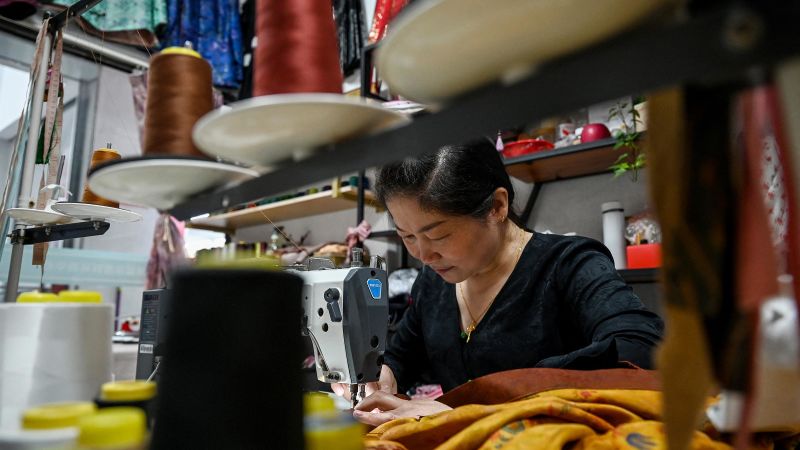CNN
—
As Trump administration officials prepare to meet with Chinese officials in Geneva this weekend, it’s tempting to believe the momentum from the United Kingdom trade deal announcement on Thursday will carry over. Don’t hold your breath.
“I’m keeping my expectations in check. Tariffs are high. Tensions are high. It’s easier to impose tariffs than to unwind them,” said Wendy Cutler, a former US trade negotiator who is now vice president of the Asia Society Policy Institute.
President Donald Trump despises trade deficits — a situation when the US buys more from another country than it sells. In his view, it’s a sign that America is being “ripped off” and treated unfairly. (Economists are much less convinced of his argument.)
Since China is the world’s second-largest economy and a manufacturing supercenter, it’s perhaps unsurprising that, across all trading partners, the US ran the largest trade deficit with Beijing last year, at nearly $300 billion.
Trump has therefore levied the steepest tariffs on China, with rates starting at a whopping 145% for most products. China responded by slapping a minimum tariff of 125% on most US goods. Both countries’ economies are poised to take massive hits from the trade war, and bruises are already beginning to appear on both sides.
Investors and many businesses and consumers from both countries are eager to see the situation improve and are holding out hope that the weekend talks, which mark the first official dialogue between top US and Chinese government officials during Trump’s second term, will help. But it could quickly turn south, too.
Cutler anticipates that Treasury Secretary Scott Bessent and US Trade Representative Jamieson Greer, who are meeting with Chinese Vice Premier He Lifeng on Saturday, will bring up the UK trade deal to show that “their policy is working” and also that other countries “have concerns with China.”
Never mind that the scant details of the UK deal reveal it’s a relatively small win — if one at all. And it was also an agreement that was relatively easy to reach.

It helps that the UK had much less to negotiate down, with tariffs on its exports starting at 10% — which, even after the “deal,” remain at those levels. Some cars from there are getting a slight break on tariffs, and the Trump administration seemed to imply other carveouts are on the table. Another positive: The US ran a $12 billion trade surplus with the UK last year.
“It’s basically balanced trade,” Cutler told CNN. China, meanwhile, is “a different animal.”
Hardly anyone believes this first round of talks will bring US and Chinese tariffs back to where they were before Trump’s second term. That includes Bessent, who told Fox News earlier this week: “My impression is that this weekend’s discussions will focus on de-escalation rather than a significant trade agreement.”
Trump even outright said he wouldn’t consider lowering tariffs to get China to the negotiating table on Wednesday. But on Thursday, citing unnamed sources, the New York Post reported that the Trump administration was considering plans to cut tariffs on China to as low as 50% as soon as next week.
In that regard, it’s a positive sign that Trump said on Thursday he wasn’t considering levying even higher tariffs on Chinese goods. “You can’t get any higher. It’s at 145, so we know it’s coming down,” Trump said in the Oval Office after announcing the UK trade deal.

Bessent’s comments about de-escalation stood out to Susan Shirk, a research professor at the UC San Diego School of Global Policy and Strategy and director emeritus of its 21st Century China Center.
“What that suggests is that this decoupling, this extreme level of tariffs, is going to move in the direction of coming down either to zero or to some minimal level on both sides,” Shirk said.
Chinese President Xi Jinping and his administration, she said, are acting in a more disciplined manner compared to previous talks with the US. That suggests to her that “they’re not likely to mess it up.”
“They’re skeptical of Trump, and so they’re going to be very careful, which I think puts the right kind of pressure on President Trump,” she said.
Shirk said she’s hoping China demonstrates how “they are making a good faith effort to reduce the flood of exports going not just to the United States but all these other countries.”
In Cutler’s view, the best possible realistic outcome of the weekend talks would be if both sides leave with “a process for further engagement,” she said. Chief among those would be getting the ball rolling on a call between Trump and Xi.
Trump suggested he’d consider speaking with Xi on Thursday depending on how the weekend talks go.
In contrast, the sky is the limit for how bad these talks could go and the actions both governments could take as a result. Both Cutler and Shirk agreed one of the worst-case scenarios would mirror the 2021 talks Biden administration officials held with Chinese officials in Alaska.
That quickly became disastrous for both sides as officials had a very public spat with one another using harsh rhetoric in front of a slew of journalists invited to cover what was initially intended to be brief opening remarks.
“The worst thing that could happen is kind of a big blowup, and the media is there to report it,” Shirk said.
“That’s exactly the type of meeting one wants to avoid,” said Cutler, who also served as acting deputy USTR in the Obama administration.
Alaska repeats aside, the worst possible outcome, she said, is for the US and China to “stake out their hard-line positions and not find common ground to move forward,” which would open the door for even higher tariffs to be imposed.


